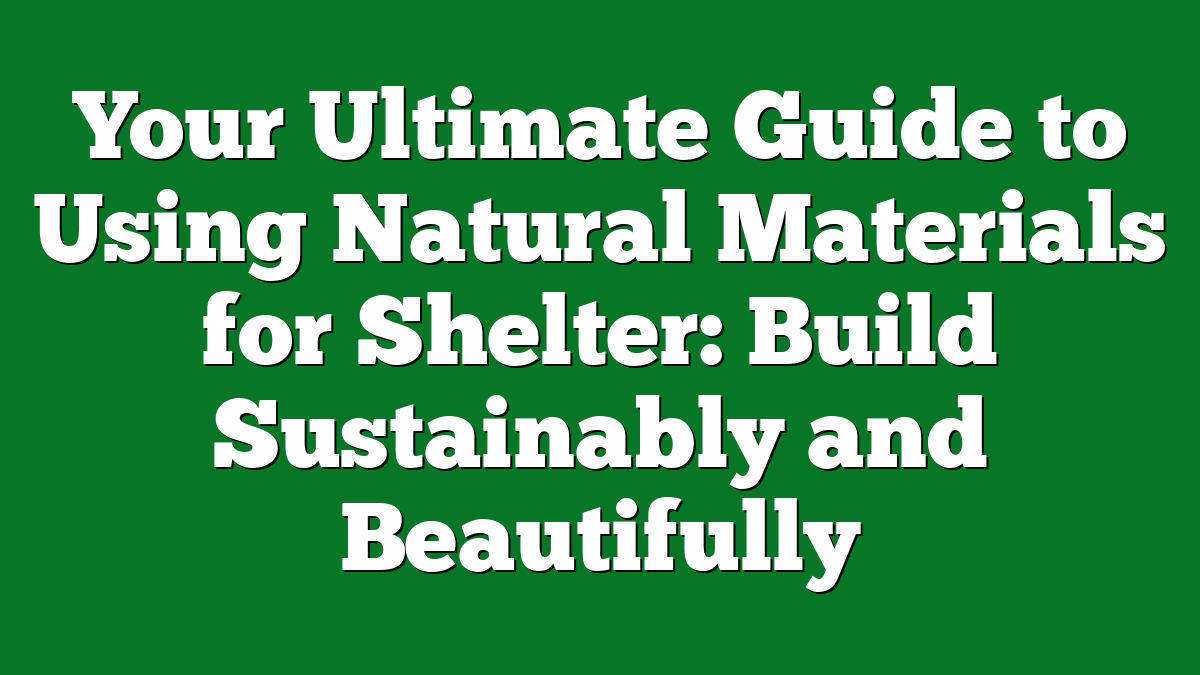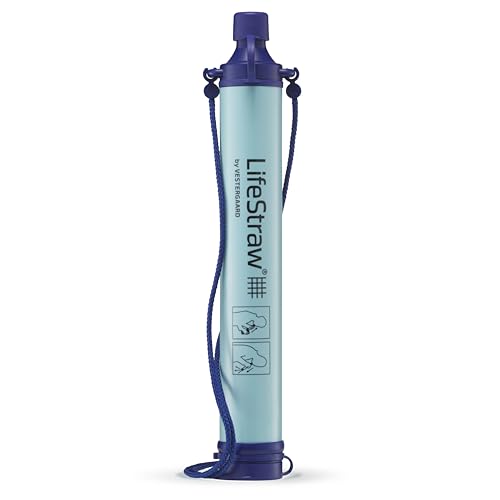When I think about shelter, I often picture cozy homes nestled in nature, blending seamlessly with their surroundings. Using natural materials for building not only creates a warm and inviting atmosphere but also promotes sustainability. It’s incredible how the earth provides us with everything we need to create a safe haven.
In this guide, I’ll explore various natural materials you can use for shelter, from timber and straw to clay and stone. Each material has its unique benefits and challenges, and I’m excited to share insights that can help you make informed choices. Whether you’re dreaming of a rustic cabin or a modern eco-home, let’s dive into the world of natural building and discover how to create spaces that are both beautiful and environmentally friendly.
Overview of Natural Materials
Natural materials serve as the backbone of sustainable shelters in the wilderness. I’ve found joy in using resources that blend seamlessly with the environment, making my camping experiences more enjoyable and eco-friendly.
Timber
Timber forms the primary structure of many rustic shelters. I often use locally sourced wood for its strength and abundance. Cedar and pine work well for framing and decking. Timber allows for easy assembly, making it ideal for temporary or permanent structures.
Straw
Straw offers excellent insulation properties. I prefer using straw bales for wall construction. They’re lightweight, easy to work with, and provide great temperature regulation. Plus, straw bales can be found on many farms, making them an accessible choice for building.
Clay
Clay acts as a versatile building material. I often use it for natural plaster or adobe-style structures. It provides durability and insulation and readily adapts to various climates. Working with clay allows me to connect with the earth, crafting a shelter that feels genuine and sturdy.
Stone
Stone is perfect for a more permanent structure. I enjoy its natural appearance and strength when building fire pits or outdoor kitchens. Rocks found around the campsite can serve as walls, combining beauty with functionality. Stone structures withstand harsh weather, offering lasting protection in the wild.
Grass and Leaves
Using grass and leaves creates excellent thatching for roofs. I often gather these materials to protect shelters from rain. They provide natural camouflage and create an inviting aesthetic. A well-thatched roof reflects a true connection to nature.
Bamboo
Bamboo presents a lightweight yet robust framework for shelters. I admire its rapid growth and sustainability. Bamboo’s flexibility lends itself well to tent-like structures. It’s great for creating supports and walls, blending functionality with beauty.
Exploring these natural materials reveals their potential for building resilient shelters. Each resource has unique properties, allowing creativity in crafting a space that resonates with nature. Embracing these materials enhances my outdoor adventures and creates a deeper appreciation for the wilderness.
Benefits of Using Natural Materials
Natural materials offer immense advantages for building shelters, especially for those who love camping and the outdoors. I appreciate how these materials enhance the camping experience while being kind to the environment.
Sustainability and Environmental Impact
Using natural materials promotes sustainability. Timber sourced from responsibly managed forests minimizes deforestation impacts. Straw bales often come from agricultural waste, reducing landfill contributions. Clay and stone require less energy for processing compared to synthetic options. Incorporating these resources lowers my carbon footprint and helps maintain ecological balance. By utilizing grass for thatching or bamboo for structures, I connect with nature and promote biodiversity, supporting wildlife habitats that enhance the outdoor experience.
Health and Well-being
Living in shelters made from natural materials significantly improves health and well-being. Materials like straw and clay are breathable, regulating temperature and humidity. This natural airflow reduces moisture issues and prevents mold growth, which keeps the air fresh and healthy. Timber’s natural aesthetics create a calming atmosphere, enhancing my outdoor experience. Natural materials don’t offgas toxic substances, ensuring that the environment is safe for both me and my camping companions. Overall, these materials not only create shelter but also foster a nurturing space that promotes relaxation and restoration while enjoying the beauty of nature.
Types of Natural Materials
When building a shelter in the great outdoors, choosing the right natural materials makes all the difference. Each material has its unique benefits, and understanding these can help me create a safe and comfortable space while camping. Here’s a look at some of the most common natural materials I use.
Wood
Wood serves as one of the most versatile materials for shelter construction. It’s readily available, strong, and relatively easy to work with. I like using timber for framework or supports due to its structural integrity and resilience against the elements. Pine and cedar work well, providing natural resistance to rot. Using branches, logs, or even fallen trees can help me quickly erect a temporary shelter. Plus, wood offers a rustic aesthetic that connects me with the surrounding environment.
Straw
Straw stands out as an excellent insulating material. When I camp in cooler climates, adding straw bales helps trap heat, making my shelter cozy. Straw is lightweight, making it easy to transport and arrange. What’s more, it’s often available from local farms, making it an accessible option. I appreciate its sustainability, as it’s a byproduct of grain production. I also love how straw can be used in combination with other materials to create a sturdy and inviting structure.
Clay
Clay is another fantastic material I often consider when building a shelter. Its natural properties allow for excellent insulation and durability. I like to use clay for wall construction or as a natural sealant to protect against moisture. When mixed with straw, it forms cob, a strong compound ideal for building. Clay is also abundant in many areas, making it an efficient choice for long-term camping sites. Its ability to regulate temperature keeps my space comfortable throughout the day and night.
Using these natural materials not only enhances my camping experience but also fosters a deeper connection with the environment. Each element plays a vital role in creating a functional and inviting shelter amidst nature.
Techniques for Building with Natural Materials
Building with natural materials requires thoughtful consideration and practical knowledge. I often focus on how these techniques enhance my camping experience, connecting me with nature while ensuring a comfortable, functional shelter.
Design Considerations
When I design a shelter using natural materials, I prioritize the landscape and climate. I assess available resources like timber and straw, ensuring they meet my needs. I consider the orientation of the structure, optimizing natural light while protecting it from harsh winds. Waterproofing is essential, so I incorporate slanted roofs using thatch or bark, preventing rain collection. I also think about ventilation, placing openings strategically to promote airflow while keeping out insects. Each design choice impacts comfort and overall performance, making it crucial to plan carefully.
Construction Methods
I utilize various construction methods for my natural shelters, each with unique benefits.
- Timber Framing: I prefer timber framing for its strength, using logs or branches to create a sturdy framework.
- Cob Construction: I mix straw and clay to create cob, which forms strong walls with excellent insulation, ideal for temperature regulation.
- Thatching: I cover roofs with thatch made from dried grass or reeds, combining traditional techniques with local materials for effective waterproofing.
- Bamboo Weaving: I turn to bamboo for its flexibility, creating lightweight structures perfect for temporary setups.
- Stone Stacking: I stack stones for a permanent base, enhancing durability and providing a natural aesthetic.
These methods not only draw on the natural environment but also encourage me to embrace creativity, allowing me to adapt my shelter to specific conditions and personal needs. Each choice reflects my commitment to a sustainable camping experience while enhancing my connection to the wilderness.
Challenges and Solutions
Building with natural materials poses certain challenges, but I’ve found ways to address them effectively.
1. Weather Resistance
Natural materials often lack the inherent weather resistance of synthetic options. For example, wood can rot in damp conditions. I ensure structures are properly treated with natural preservatives, like linseed oil, to enhance their longevity. Additionally, employing techniques such as constructing sloped roofs or elevated foundations prevents moisture accumulation.
2. Insulation
While materials like straw provide excellent insulation, achieving a specific R-value can be complicated. I often layer straw with additional insulating materials such as wool or specific types of soil to improve temperature regulation. This combination offers a cozy space, crucial for chilly nights in the wilderness.
3. Sourcing Materials
Finding quality natural building materials isn’t always straightforward. Depending on the location, access to timber, clay, or straw can vary. I scout local areas, considering what’s sustainably available. Joining local building communities or forums often aids in sharing resources and sourcing materials responsibly.
4. Skill Level
Many campers may hesitate to build their own shelters due to a perceived lack of skills. Knowing this, I recommend starting small. I practice basic techniques like timber framing or cobbing on a smaller scale before attempting larger projects. Workshops or online tutorials also provide invaluable guidance for hands-on learners.
5. Time Investment
Constructing a shelter from natural materials can require significant time, more so than setting up a traditional tent. I prioritize planning my projects during off-seasons or incorporate building tasks during longer camping trips, allowing me to blend leisure with learning.
6. Wildlife Interaction
Natural shelters can attract wildlife, which can be both a concern and a thrill. To mitigate unwanted visits, I keep the area clean from food scraps and set up biobulk barriers made of natural materials to create a protective perimeter.
Focusing on these challenges and their solutions enhances my camping experience. Natural shelters don’t just connect me to the land; they also promote a sustainable lifestyle.
Conclusion
Embracing natural materials for shelter has opened up a world of possibilities for creating beautiful and sustainable living spaces. I’ve found that these materials not only enhance our connection to nature but also promote a healthier lifestyle.
Whether you’re building a cozy cabin or a simple camping structure, the unique properties of timber, straw, clay, and stone offer endless opportunities for creativity and design.
While there are challenges to consider, the rewards of crafting a home that resonates with the environment are truly worth it. I hope you feel inspired to explore these options and embark on your own journey of building with nature.











